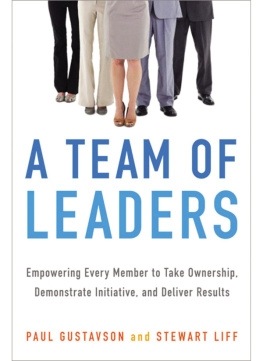Bulk discounts available. For details visit:
All rights reserved. No portion of this book may be reproduced, stored in a retrieval system, or transmitted in any form or by any meanselectronic, mechanical, photocopy, recording, scanning, or otherexcept for brief quotations in critical reviews or articles, without the prior written permission of the publisher.
Published by HarperCollins Leadership, an imprint of HarperCollins Focus LLC .
Any internet addresses, phone numbers, or company or product information printed in this book are offered as a resource and are not intended in any way to be or to imply an endorsement by HarperCollins Leadership, nor does HarperCollins Leadership vouch for the existence, content, or services of these sites, phone numbers, companies, or products beyond the life of this book.
Gustavson, Paul.
A team of leaders : empowering every member to take ownership, demonstrate initiative, and deliver results / Paul Gustavson and Stewart Liff.
Includes bibliographical references and index.
ISBN 978-0-8144-3407-9 ISBN 0-8144-3407-X 1. Teams in the workplace. 2.
Employee motivation. I. Liff, Stewart. II. Title.
Please note that footnotes in this ebook may contain hyperlinks to external websites as part of bibliographic citations. These hyperlinks have not been activated by the publisher, who cannot verify the accuracy of these links beyond the date of publication.
WE COULD NOT HAVE written this book, of course, without the generosity of great mentors.
While playing football for Brigham Young University, I marveled at Hall of Fame coach LaVell Edwards and his methods for building a very good team. I count as one of the great blessings in my life to have been accepted into the BYU Masters of Organizational Behavior Program, where I had the privilege to be a teaching and research assistant to the late Bill Dyer, who in many circles is credited with being the father of team building. Bill always encouraged me to write about what I was learning about teams. Now I am sure that Bill is smiling.
I am grateful to the late Forrest Belcher, who trusted and gave me his earliest opportunities to apply the team-building knowledge in the workplace while at Standard Oil of Indiana. Likewise, I am grateful for Federico Faggin and Manny Fernandez at Zilog, who encouraged and supported me in one of the first work innovations with teams in the high-tech industry, creating extraordinary results and a competitive advantage in manufacturing, product development, and customer service.
I am indebted to many clients over the years that provided me with great projects where building high-performance teams helped to create a strategic competitive advantage. These partnerships contributed to the development and refinement of many of the tools and techniques presented in this book.
I am also grateful for all those in his learning community who inspired and encouraged me to write about my experiencesDave Ulrich, Kerry Patterson, Herb Stokes, John Cotter, Jim Taylor, Bronco Mendenhall, Norm Smallwood, Stephen M. R. Covey, Gibb Dyer, Ralph Christensen, Jeff Dyer, Craig Hunt, Michael Colemere, Richard Feller, Ann Henry, David Nielson, Claire Averett, Kreig Smith, Kyle Smith, Bret Thomas, Bill Scholz, May Speck, Mark Richards, Marc Swartz, Tom Ward, Tom Stone, Irv Rothman, Gerri Gold, Jim Tenner, Elliot Cooperstone, Starr Eckholdt, Bill Veltrop, Tim OHara, Shawn Brenchley, the late Cal Pava, Bonner Ritchie, Scott Jensen, Bruce Diamond, the late Steve Crossingham, and many others.
- Paul Gustavson
I would like to thank many of the people over the years that helped build my expertise in management and team development. They include Joe Thompson, Tom Lastowka, Rick Nappi, Nora Egan, Dave Walls, Ray Avent, John Vogel, Dan Kowalski, Paul Draper, Alan Checketts, Gary Turner, and Herman Greenspan.
I would like to acknowledge the contribution of Pamela A. Posey, D.B.A., to our joint work on visual management. For further details about visual management, see Stewart Liff and Pamela A. Posey, Seeing Is Believing: How the New Art of Visual Management Can Boost Performance Throughout Your Organization (New York: AMACOM, 2004), or visit www.stewartliff.com and www.EyesOnPerformance.com.
I would also like to thank Professors Harold Bruder, Gabriel Laderman, and Robert Bermelin, who greatly contributed to my education in the fine arts. Their teachings, combined with my business experience and continued growth, led to the concept of visual management as described in this book.
Finally, I would like to thank my many friends and colleagues over the years that helped open my eyes and provide me with the support and encouragement I needed to continue to grow. They include Dennis Kuewa, Pat Amberg-Blyskal, Barry Jackson, Ed Russell, Mike Harris, Bruce Petroff, Jenn Kler, Grant Singleton, Anne Haines, Lynda Russell, Ev Chasen, Veronica Wales, Monty Watson, Ventris Gibson, Susan Fishbein, Mike Walcoff, and Jeff Liff.
- Stewart Liff
Collectively, we would like to offer many thanks to our editors, Christina Parisi and Stephen Power, who guided us though the publication process, as well as to our other colleagues at AMACOM, all of whom provided wise advice and editorial support.
We would like to give special thanks to Elaine Biech for her untiring support and assistance on this project. We would also like to thank Scott Edelstein for his many insights and expertise on the entire publishing process.
We offer grateful thanks to our dear colleagues Mark Rhodes, Bill Snyder, and Alyson Von Feldt, who contributed deeply to our thinking and writing. We would also like to thank our colleagues at the Woodlands Group for the many years of intellectual stimulation and friendship they have provided us.
Finally, a big hurrah for Paul and Kris Annes four children: Jule, Amber, April, and Jason, and to Stew and Lisas family of six children: Rob, Jen, Marc, Matt, Rob C., and Amy. They were the ultimate test labs for these principles and concepts, and they are our most important teams. Each of them takes great interest in being a team of leaders.
Our heartiest thanks go to Kris Anne and Lisa, our wives, who encouraged us to collaborate on a book for years and helped make this book-writing project a terrific experience.
How do you create an environment that successfully addresses the many challenges that supervisors and employees deal with while producing outstanding performance? The answer is simple: You have to create an environment where everyone is a leader. That is, an environment where everyone works together, takes the initiative, assumes ownership, is willing to deal with difficult issues, and accepts accountability for the teams results; an environment that is in stark contrast with one in which the supervisor tries to get everyone to produce.
This is a fundamental change in the way that most work entities operate. However, as we will show you, such a workplace design will produce better performance and make your work life much more exciting, enjoyable, and fulfilling.











